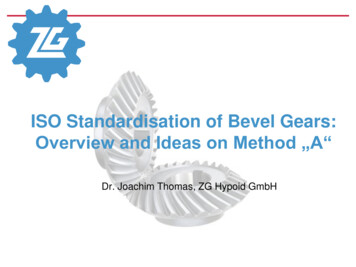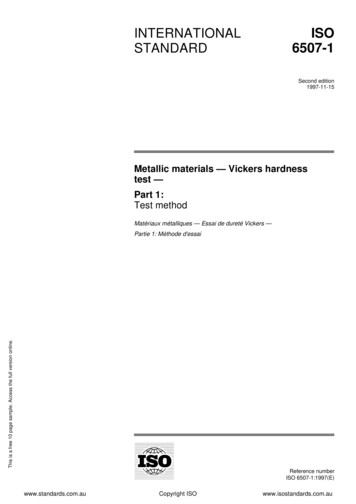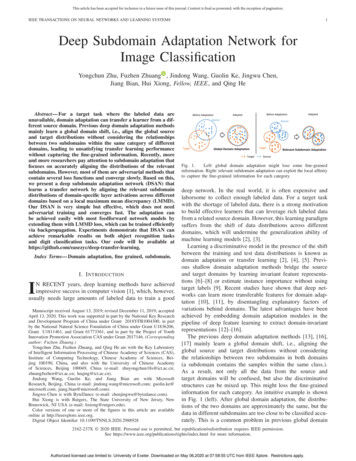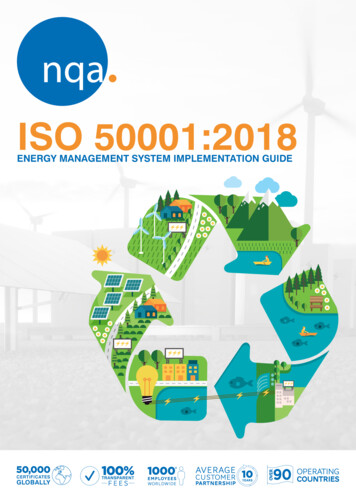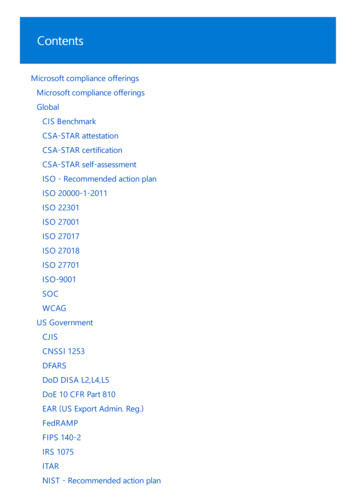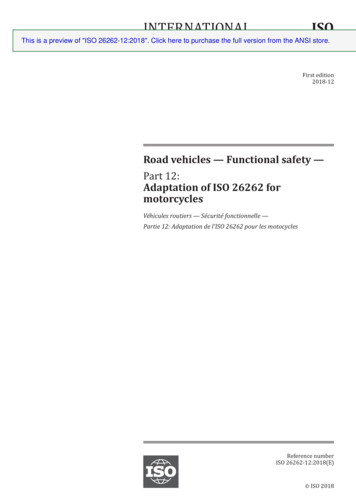
Transcription
ISOINTERNATIONALThis is a preview of "ISO 26262-12:2018". Click here to purchase the full version from the ANSI store.STANDARD26262-12First edition2018-12Road vehicles — Functional safety —Part 12:Adaptation of ISO 26262 formotorcyclesVéhicules routiers — Sécurité fonctionnelle —Partie 12: Adaptation de l'ISO 26262 pour les motocyclesReference numberISO 26262-12:2018(E) ISO 2018
ISO 26262-12:2018(E) This is a preview of "ISO 26262-12:2018". Click here to purchase the full version from the ANSI store.COPYRIGHT PROTECTED DOCUMENT ISO 2018All rights reserved. Unless otherwise specified, or required in the context of its implementation, no part of this publication maybe reproduced or utilized otherwise in any form or by any means, electronic or mechanical, including photocopying, or postingon the internet or an intranet, without prior written permission. Permission can be requested from either ISO at the addressbelow or ISO’s member body in the country of the requester.ISO copyright officeCP 401 Ch. de Blandonnet 8CH-1214 Vernier, GenevaPhone: 41 22 749 01 11Fax: 41 22 749 09 47Email: copyright@iso.orgWebsite: www.iso.orgPublished in Switzerlandii ISO 2018 – All rights reserved
ISO 26262-12:2018(E) This is a preview of "ISO 26262-12:2018". Click here to purchase the full version from the ANSI store.Contents PageForeword.vIntroduction. vi12345678910Scope. 1Normative references. 2Terms and definitions. 2Requirements for compliance. 24.1Purpose. 24.2General requirements. 24.3Interpretations of tables. 34.4ASIL-dependent requirements and recommendations. 34.5Adaptation for motorcycles. 44.6Adaptation for trucks, buses, trailers and semi-trailers. 4General topics for adaptation for motorcycles. 45.1Objectives. 45.2General. 4Safety culture. 56.1Objective. 56.2Requirements and recommendations. 5Confirmation measures. 67.1Objective. 67.2Requirements and recommendations. 6Hazard analysis and risk assessment.118.1Objectives. 118.2General. 128.3Input to this clause. 128.3.1Prerequisites. 128.3.2Further supporting information. 128.4Requirements and recommendations. 128.4.1Initiation of the hazard analysis and risk assessment. 128.4.2Situation analysis and hazard identification. 128.4.3Classification of hazardous events. 138.4.4Determination of safety goals. 178.4.5Verification. 178.5Work products. 18Vehicle integration and testing.189.1Objective. 189.2Requirements and recommendations. 189.2.1Vehicle integration. 189.2.2Test goals and test methods during vehicle testing. 18Safety validation.2010.1 Objective. 2010.2 General. 2110.3 Inputs to this clause. 2110.3.1 Prerequisites. 2110.3.2 Further supporting information. 2110.4 Requirements and recommendations. 2110.4.1 Safety validation environment. 2110.4.2 Specification of safety validation. 2110.4.3 Execution of safety validation. 2210.4.4 Evaluation. 23 ISO 2018 – All rights reserved iii
ISO 26262-12:2018(E) This is a preview of "ISO 26262-12:2018". Click here to purchase the full version from the ANSI store.10.5Work products. 23Annex A (informative) Overview of and workflow of adaptation of the ISO 26262 series ofstandards for motorcycles.24Annex B (informative) Hazard analysis and risk assessment for motorcycles.30Annex C (informative) Example of controllability classification techniques.38Bibliography. 42iv ISO 2018 – All rights reserved
ISO 26262-12:2018(E) This is a preview of "ISO 26262-12:2018". Click here to purchase the full version from the ANSI store.ForewordISO (the International Organization for Standardization) is a worldwide federation of national standardsbodies (ISO member bodies). The work of preparing International Standards is normally carried outthrough ISO technical committees. Each member body interested in a subject for which a technicalcommittee has been established has the right to be represented on that committee. Internationalorganizations, governmental and non-governmental, in liaison with ISO, also take part in the work.ISO collaborates closely with the International Electrotechnical Commission (IEC) on all matters ofelectrotechnical standardization.The procedures used to develop this document and those intended for its further maintenance aredescribed in the ISO/IEC Directives, Part 1. In particular, the different approval criteria needed for thedifferent types of ISO documents should be noted. This document was drafted in accordance with theeditorial rules of the ISO/IEC Directives, Part 2 (see www .iso .org/directives).Attention is drawn to the possibility that some of the elements of this document may be the subject ofpatent rights. ISO shall not be held responsible for identifying any or all such patent rights. Details ofany patent rights identified during the development of the document will be in the Introduction and/oron the ISO list of patent declarations received (see www .iso .org/patents).Any trade name used in this document is information given for the convenience of users and does notconstitute an endorsement.For an explanation on the voluntary nature of standards, the meaning of ISO specific terms andexpressions related to conformity assessment, as well as information about ISO's adherence to theWorld Trade Organization (WTO) principles in the Technical Barriers to Trade (TBT) see the followingURL: www .iso .org/iso/foreword .html.This document was prepared by Technical Committee ISO/TC 22, Road vehicles, Subcommittee SC 32,Electrical and electronic components and general system aspects.Any feedback or questions on this document should be directed to the user’s national standards body. Acomplete listing of these bodies can be found at www .iso .org/members .html.A list of all parts in the ISO 26262 series can be found on the ISO website. ISO 2018 – All rights reserved v
ISO 26262-12:2018(E) This is a preview of "ISO 26262-12:2018". Click here to purchase the full version from the ANSI store.IntroductionThe ISO 26262 series of standards is the adaptation of IEC 61508 series of standards to address thesector specific needs of electrical and/or electronic (E/E) systems within road vehicles.This adaptation applies to all activities during the safety lifecycle of safety-related systems comprisedof electrical, electronic and software components.Safety is one of the key issues in the development of road vehicles. Development and integration ofautomotive functionalities strengthen the need for functional safety and the need to provide evidencethat functional safety objectives are satisfied.With the trend of increasing technological complexity, software content and mechatronicimplementation, there are increasing risks from systematic failures and random hardware failures,these being considered within the scope of functional safety. ISO 26262 series of standards includesguidance to mitigate these risks by providing appropriate requirements and processes.To achieve functional safety, the ISO 26262 series of standards:a)provides a reference for the automotive safety lifecycle and supports the tailoring of the activitiesto be performed during the lifecycle phases, i.e., development, production, operation, service anddecommissioning;b) provides an automotive-specific risk-based approach to determine integrity levels [AutomotiveSafety Integrity Levels (ASILs)];c)uses ASILs to specify which of the requirements of ISO 26262 are applicable to avoid unreasonableresidual risk;e)provides requirements for relations between customers and suppliers.d) provides requirements for functional safety management, design, implementation, verification,validation and confirmation measures; andThe ISO 26262 series of standards is concerned with functional safety of E/E systems that is achievedthrough safety measures including safety mechanisms. It also provides a framework within whichsafety-related systems based on other technologies (e.g. mechanical, hydraulic and pneumatic) can beconsidered.The achievement of functional safety is influenced by the development process (including suchactivities as requirements specification, design, implementation, integration, verification, validationand configuration), the production and service processes and the management processes.Safety is intertwined with common function-oriented and quality-oriented activities and workproducts. The ISO 26262 series of standards addresses the safety-related aspects of these activities andwork products.Figure 1 shows the overall structure of the ISO 26262 series of standards. The ISO 26262 series ofstandards is based upon a V-model as a reference process model for the different phases of productdevelopment. Within the figure:— the shaded “V”s represent the interconnection among ISO 26262-3, ISO 26262-4, ISO 26262-5,ISO 26262-6 and ISO 26262-7;— for motorcycles:— ISO 26262-12:2018, Clause 8 supports ISO 26262-3;— ISO 26262-12:2018, Clauses 9 and 10 support ISO 26262-4;— the specific clauses are indicated in the following manner: “m-n”, where “m” represents the numberof the particular part and “n” indicates the number of the clause within that part.vi ISO 2018 – All rights reserved
ISO 26262-12:2018(E) This is a preview of "ISO 26262-12:2018". Click here to purchase the full version from the ANSI store.EXAMPLE“2-6” represents ISO 26262-2:2018, Clause 6.Figure 1 — Overview of the ISO 26262 series of standards ISO 2018 – All rights reserved vii
The ISO 26262 series of standards is based upon a V-model as a reference process model for the different phases of product development. Within the figure: — the shaded "V"s represent the interconnection among ISO 26262-3, ISO 26262-4, ISO 26262-5, ISO 26262-6 and ISO 26262-7; — for motorcycles:




